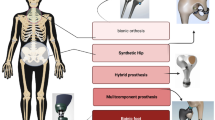Abstract
Nitinol (nickel–titanium) alloys exhibit a combination of properties which make these alloys particularly suited for self-expanding stents. Some of these properties cannot be found in engineering materials used for stents presently. This article explains the fundamental mechanism of shape memory and superelasticity, and how they relate to the characteristic performance of self-expanding stents. Nitinol stents are manufactured to a size slightly larger than the target vessel size and delivered constrained in a delivery system. After deployment, they position themselves against the vessel wall with a low, "chronic" outward force. They resist outside forces with a significantly higher radial resistive force. Despite the high nickel content of Nitinol, its corrosion resistance and biocompatibility is equal to that of other implant materials. The most common Nitinol stents are listed and described.






















Similar content being viewed by others
References
Dotter CT, Buschmann PAC, McKinney MK, Rösch J (1983) Transluminal expandable nitinol coil stent grafting: preliminary report. Radiology 147:259
Shabalovskaya S (1996) On the nature of the biocompatibility and medical applications of NiTi shape memory and superelastic alloys. Bio Med Mat Eng 6:267
Duerig TW, Melton KN, Wayman CM, Stöckel D (1990) Engineering aspects of shape-memory alloys. Butterworth-Heinemann, London
Stoeckel D (2000) Nitinol medical devices and implants. Min Invas Ther Allied Technol 9:81
ASTM F 2063–00 (2002) Standard specification for wrought nickel–titanium shape-memory alloys for medical devices and surgical implants
ASTM F 2004–00 (2002) Test method for transformation temperature of nickel-titanium alloys by thermal analysis
ASTM F 2082–01 (2002) Method for the determination of transformation temperature of nickel–titanium shape-memory alloys by bend and free recovery
Pelton AR, DiCello J, Miyazaki S (2000) Optimisation of processing and properties of medical grade Nitinol wire. Min Invas Ther Allied Technol 9:107
Wever DJ, Veldhuizen AG, Sanders MM, Schakenraad JM (1997) Cytotoxic, allergic and genotoxic activity of a nickel–titanium alloy. Biomaterials 18:1115
Wever DJ, Veldhuizen AG, de Vries J, Busscher HJ, Uges DRA, van Horn JR (1998) Electrochemical and surface characterization of a nickel–titanium alloy. Biomaterials 19:761
Brown SA, Hughes PJ, Merritt K (1988) In vitro studies of fretting corrosion of orthopaedic materials. J Orthop Res 6:572
Barrett RD, Bishara SE, Quinn JK (1993) Biodegradation of orthodontic appliances: part I, biodegradation of nickel and chromium in vitro. Am J Orthod Dentofac Orthop 103:8
Bishara SE, Barrett RD, Selim MI (1993) Biodegradation of orthodontic appliances. Part II: Changes in the blood level of nickel. Am J Orthod Dentofac Orthop 103:115
Ryhanen J, Niemi E, Serlo W, Niemelä E, Sandvik P, Pernu H, Salo T (1997) Biocompatibility of nickel–titanium shape-memory metal and its corrosion behavior in human cell cultures. J Biomed Mater Res 35:451
Trepanier C, Venugopolan R, Messer R, Zimmerman J, Pelton AR (2000) Effect of passivation treatments on nickel release from Nitinol. Proc Soc Biomater:1043
ASTM F2129–01 (2002) Standard test method for conducting cyclic potentiodynamic polarization measurements to determine the corrosion susceptibility of small implant devices
Trepanier C, Tabizian M, Yahia LH, Bilodeau L, Piron DL (1998) Effect of modification of oxide layer on NiTi stent corrosion resistance. J Biomed Mater Res 43:433
Trepanier C, Fino J, Zhu L, Pelton AR (2002) Corrosion resistance of oxidized Nitinol. SMST
Heintz C, Riepe G, Birken L, Kaiser E, Chafke N, Morlock M, Delling G, Imig H (2001) Corroded Nitinol wires in explanted aortic endografts: an important mechanism of failure? J Endovasc Ther 8:248
Kaiser E (2002) Cell-induced corrosion in vitro. Second European Sym Vasc Biomat, Hamburg
Duerig TW, Pelton AR, Stöckel D (1996) The use of superelasticity in medicine. Metall 50:569
Duerig TW, Tolomeo DE, Wholey M (2000) An overview of superelastic stent design. Min Invas Ther Allied Technol 9:235
Harnek J, Zoucas E, Stenram U, Cwikiel W (2002) Insertion of self-expandable Nitinol stents without previous balloon angioplasty reduces restenosis compared with PTA prior to stenting. Cardiovasc Intervent Radiol 5:430
Duda S, Wiskirchen J, Tepe G, Bitzer M, Kaulich TW, Stoeckel D, Claussen C (2000) Physical properties of endovascular stents: an experimental comparison. J Vasc Interv Radiol 11:645
Sigwart U (1996) The coiled sheet concept. In: Sigwart U (ed) Endoluminal stenting. Saunders, London, pp 249–250
Stoeckel D, Bonsignore C, Duda S (2002) A survey of stent designs. Min Invas Ther Allied Technol 11:137
Author information
Authors and Affiliations
Corresponding author
Rights and permissions
About this article
Cite this article
Stoeckel, D., Pelton, A. & Duerig, T. Self-expanding nitinol stents: material and design considerations. Eur Radiol 14, 292–301 (2004). https://doi.org/10.1007/s00330-003-2022-5
Received:
Revised:
Accepted:
Published:
Issue Date:
DOI: https://doi.org/10.1007/s00330-003-2022-5




